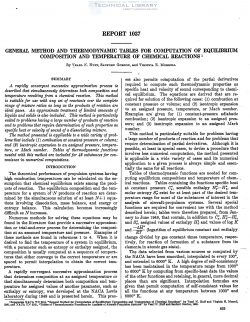naca-report-1037

- Version
- 167 Downloads
- 5.24 MB File Size
- 1 File Count
- September 1, 2016 Create Date
- September 1, 2016 Last Updated
National Advisory Committee for Aeronautics, Report - General Method and Thermodynamic Tables for Computation of Equilibrium Composition and Temperature of Chemical Reactions

A rapidly concergent successive approximation process is
described that simultaneously determines both composition and
temperature resulting from a chemical reaction. This method
is suitable for use with any set of reactants over the complete
range of mirture ratios as long as the products of reaction- are
ideal gases. An approrimate treatment of limited amounts of
liquids and solids is also included. ibis method is particularly
suited to problems hating a large number of products of reaction
and to problems that require determination of such properties as
specific heat or velocity of sound of a dissociating mixture.
The method presented is applicable to a wide variety of prob-
lems that include (I) combustion at constant pressure or volume;
and (2) isent-ropic expansion. to an assigned pressure, tempera—
ture, or llfach number. Tables of thermodynamic functions
needed with this method are included for 42 substances for con-
venience in numerical computations.
The theoretical performance of propulsion systems having
high combustion temperatures can be calculated on the as-
sumption that chemical equilibrium exists among the prod-
ucts of reaction. The equilibrium composition and the tem-
perature for a system 'of’N products of reaction are deter-
mined by the simultaneous solution of at least N+1 equa-
tions involving dissociation, mass balance, and energy or
entropy balance. This calculation becomes increasingly
difficult as N increases.
Numerous methods for solving these equations may be
found in the literature that provide a successive approxima-
tion or trial-and-error process for determining the composi-
tion at an assumed temperature and pressure. Examples of
these methods are found in references 1 to 4. When it is
desired to find the temperature of a system in equilibrium,
with a parameter such as entropy or enthalpy assigned, the
composition is usually computed at a sequence of tempera-
tures that either converge to the correct temperature or are
spaced to permit interpolation to obtain the correct tem-
perature.
| File | Action |
|---|---|
| naca-report-1037 General Method and Thermodynamic Tables for Computation of Equilibrium Composition and Temperature of Chemical Reactions.pdf | Download |

Comment On This Post